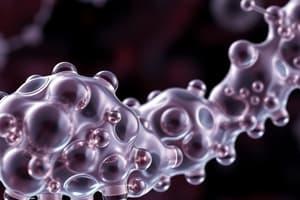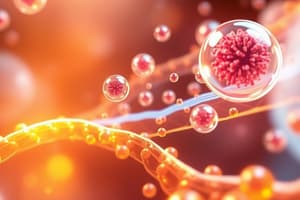Podcast
Questions and Answers
What is the main function of lipids in living cells?
What is the main function of lipids in living cells?
- Energy storage
- Structural component of cell membranes
- Hormone production
- All of the above (correct)
Which of these characteristics is NOT typical of fatty acids?
Which of these characteristics is NOT typical of fatty acids?
- They have a long, aliphatic chain.
- They are mostly found in esterified form in nature.
- They are branched molecules. (correct)
- They are amphipathic, meaning they have both hydrophobic and hydrophilic properties.
What is the difference between saturated and unsaturated fatty acids?
What is the difference between saturated and unsaturated fatty acids?
- Saturated fatty acids are generally liquid at room temperature, while unsaturated fatty acids are solid.
- Saturated fatty acids are found in plants, while unsaturated fatty acids are found in animals.
- Saturated fatty acids contain single bonds between carbons, while unsaturated fatty acids contain at least one double bond. (correct)
- Saturated fatty acids contain double bonds, while unsaturated fatty acids do not.
Which lipoprotein is primarily responsible for transporting cholesterol from tissues to the liver?
Which lipoprotein is primarily responsible for transporting cholesterol from tissues to the liver?
What is the disorder that results from lipoprotein dysfunction and can lead to hardening of the arteries?
What is the disorder that results from lipoprotein dysfunction and can lead to hardening of the arteries?
Flashcards
Lipid
Lipid
Molecules containing hydrocarbons, essential for cell structure and energy storage.
Fatty Acids
Fatty Acids
Long-chain carboxyl acids that are either saturated or unsaturated.
Triglyceride
Triglyceride
A type of lipid used primarily for energy storage; consists of glycerol and three fatty acids.
Phospholipid
Phospholipid
Signup and view all the flashcards
Lipoprotein
Lipoprotein
Signup and view all the flashcards
Study Notes
Lipids
- Lipids are molecules containing hydrocarbons.
- They are a major component in the structure and function of living cells.
- Lipids are the main molecules for energy storage (triglycerides/triacylglycerols).
- These lipids are non-polar.
- Polar lipids are crucial components of biological membranes, forming lipid bilayers.
- Steroids, chlorophyll, carotenoids, and retinol are also types of lipids.
- Some lipids function as fat-soluble vitamins (A, D, E, and K).
- Lipids like ubiquinone (UQ or CoQ) and plastoquinone (PQ) act as electron transport carriers in chloroplasts and mitochondria.
Classification of Lipids
-
Fatty acids (FA): Long hydrocarbon chains (14-30 carbons), typically even-numbered, with a carboxyl group (COOH) at one end and a methyl group (CH3) at the other.
- Amphipathic (both hydrophilic/polar head and hydrophobic/non-polar tail)
- In nature, they are typically esterified to glycerol, preventing toxicity if free in their un-esterified form.
- Usually have C-C single bonds.
- Saturated or unsaturated (double bonds).
-Most unsaturated FAs have cis configuration of double bonds and are unconjugated.
- FAs with fewer than 12 carbons are soluble in water.
- FAs are soluble in dilute NaOH/KOH to produce soap (via saponification).
-
Triglycerides/Triacylglycerols (TG): Three fatty acid molecules esterified to one glycerol molecule.
- Stored as fats and oils in animals and plants.
- Not soluble in water.
- Provide energy reserve.
- Can be simple or mixed.
-
Phospholipids: Glycerol, two fatty acids, a phosphate group, and a polar group (like choline, ethanolamine, serine, inositol)
- Also known as phosphoglycerides or glycerophospholipids
- Many polar groups can be esterified to the phosphate group at C3
- Key components of biological membranes.
- Have hydrophilic/polar head and hydrophobic/non-polar tail.
-
Sphingolipids: Sphingosine (18 carbon alcohol) substitutes glycerol
-
Contain a fatty acid and a polar head group -Ceramides: fatty acid attached to sphingosine -Sphingomyelins: a ceramide with a phosphocholine or phosphoethanolamine head group -Glycosphingolipids: include cerebrosides (contain a sugar, galactose or glucose) and gangliosides (contain more complex sugar chains).
-
Waxes: Esters of long-chain fatty acids and long-chain alcohols, highly insoluble.
- Found in animal skins and the surface of certain fruits.
- Provide waterproofing.
- Include lanolin and spermaceti.
-
Steroids: Important group of terpenes, performing various functions in cells, including hormone production.
- Includes androgens (e.g., testosterone), estrogens (e.g., estradiol), progestogens (progesterone), glucocorticoids (e.g., cortisol), mineralocorticoids, and bile acids (e.g., cholic acid).
- Cholesterol: A crucial steroid.
- Four interconnected hydrocarbon rings.
- Important component in cell membranes and the precursor to many other steroid hormones.
-
Lipoproteins: Complexes of lipids and proteins that transport lipids through the blood.
- Different types (chylomicrons, VLDL, IDL, LDL, HDL).
- Associated with cholesterol transport and cardiovascular health
-
Trans Fats: Unsaturated fats with trans-isomer fatty acids.
- Produced by partially hydrogenating unsaturated fats.
- Increase in blood cholesterol levels, contributing to heart disease.
Studying That Suits You
Use AI to generate personalized quizzes and flashcards to suit your learning preferences.




